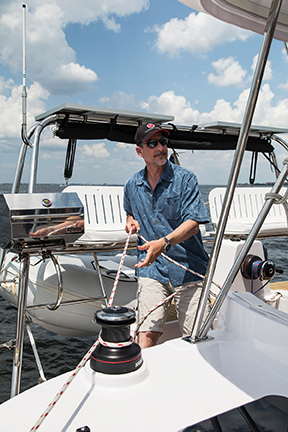Antares University provides new and prospective owners a program that details the boat from stem to stern (published September 2015)
The breeze brought relief to a warm day on the water in southern Florida, and as we sailed at 9.3 knots in 14 knots of steady wind, tracking a thunderstorm in the distance on radar, we looked at each other with grins on our faces, picturing ourselves in the same position with our girls in a couple of years, only on our own boat. The one we were sailing currently was S/V Exit Strategy, an Antares 44i, generously on loan by its owners for the company’s program, Antares University, a fantastic opportunity to get to know the boat in great detail before taking delivery of our own.
Looking for and buying a boat is an exciting but daunting journey. Add to that, that we plan on living aboard with our two young daughters, finding the optimal boat for safety, comfort, and security has been paramount.
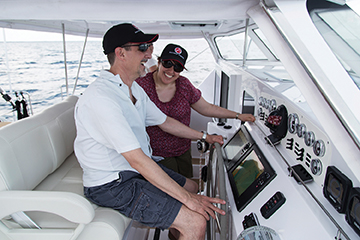
When we looked at other catamarans on the market, none had the safety features that we found on the Antares, and none was built with the same mindset for world cruising. Despite the many (many!) hours that we had spent on the website, as well as several boat shows, we didn’t fully appreciate, though, just how well-thought out and well-built the Antares was until we were able to participate in the unique Antares University.
Twice a year, Rob Poirier, Jeff Woodman and Salwa Farah of Antares Yachts, offer a program to new and prospective owners that details the boat stem to stern, going through the systems, sail setup, anchoring, boat handling and docking. An Antares owner will open up their boat to four to five couples at a time for a two to three day workshop on the boat, where everyone is walked through the systems in smaller groups step-by-step, taking complex systems and making them easy to understand.
We’ve been fortunate to attend two of these programs this year, one on S/V Indigo in San Diego, CA, and most recently on S/V Exit Strategy in Punta Gorda, FL. We didn’t know quite what to expect our first day and were somewhat nervous about the prospect of being at the helm of someone else’s boat, especially a 44 foot catamaran. Coming from a monohull background (we have previously owned 23 and 44 foot monohulls), the sailing and handling of a cat is a different experience. Although we’ve chartered catamarans before, this felt more intimidating. Any nervousness we felt, however, was quickly forgotten with the laid-back atmosphere and friendly environment set by the Antares crew. We were greeted with big smiles and hugs by Rob, Jeff, and Salwa, and our day of learning began.
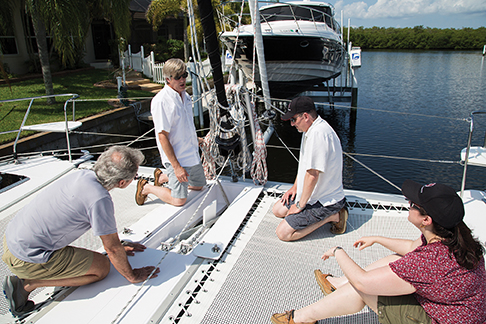
Once we had a chance to meet the other students attending, Rob and Jeff split up the group each morning, going through the systems in detail. For example, Jeff went through the water system. He lifted up all of the floor boards, starting at the front of the boat and working aft, talked about each component of the system, how they all function, how to service them, and how to think logically about the system to troubleshoot problems—like how to clear the inevitable seaweed or marine growth from the raw water intake for the engine.
We also learned about the electrical systems in detail when Rob walked us through the breaker board and wiring beneath. For instance, the boat has a battery charge combiner, which we didn’t fully appreciate until attending Antares University. A standard requirement on commercial vessels, it effectively allows top-off trickle charging of all the battery banks, but disconnects them as you draw the house bank down so that your engine batteries always remain fully charged. You can also combine all of the battery banks in an emergency to start an engine. Understanding these complex systems has given us further peace of mind when we’re planning to spend extended periods of time in remote parts of the world.
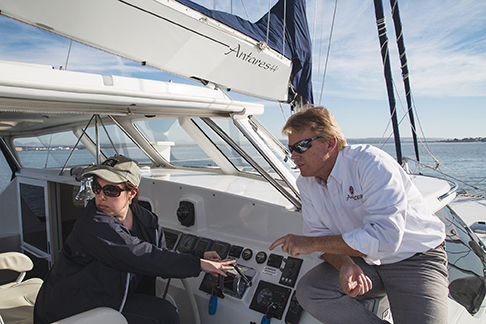 When you see a boat at a boat show, you get to see it only at a certain level of detail. There are crowds and logistical roadblocks to a more thorough viewing. But what we were able to do at Antares University is to have the time and ability to go through the boat and really scrutinize everything. We got to really get a look in all of the nooks and crannies. We got to crawl into lockers to look at the installation of the generator, the AC units, the watermaker—any space that we wanted to explore. And with this type of access, it brought home to us how well-thought out the systems are, and the quality and attention to detail that is unmatched. And with questions about why things were designed the way they were, there is always a sound, logical reason. This is a boat in which we have full confidence crossing oceans with our family.
When you see a boat at a boat show, you get to see it only at a certain level of detail. There are crowds and logistical roadblocks to a more thorough viewing. But what we were able to do at Antares University is to have the time and ability to go through the boat and really scrutinize everything. We got to really get a look in all of the nooks and crannies. We got to crawl into lockers to look at the installation of the generator, the AC units, the watermaker—any space that we wanted to explore. And with this type of access, it brought home to us how well-thought out the systems are, and the quality and attention to detail that is unmatched. And with questions about why things were designed the way they were, there is always a sound, logical reason. This is a boat in which we have full confidence crossing oceans with our family.
As much as we learned at the first program, we picked up a lot the second time around. Understanding the complex systems of such a boat takes time. Each student is provided with a thick booklet outlining the systems as an overview, with a lot of great information that supplements the owner’s manuals received with delivery of the boat. And since the two boats were equipped slightly differently, we got to see the various options in use. For instance, in Punta Gorda we got to see the installed hookah dive system in use as the owner dived to clear a fouled prop.
Also, throughout the two-day class, Jeff and Rob gave lots of great additional hands-on advice. Knowing that we will be cruising with our daughters, they gave us numerous safety tips related to having our young girls on board, such as where the breaker for the winches is so we can consider throwing it while at anchor to avoid pinched fingers, or that the gas solenoid switch in the galley controls the barbecue as well, in case one of the girls gets overly helpful and turns it off while we’re grilling dinner on deck.
The afternoon each day brought boat handling, anchoring and sailing. Having Jeff sit at the helm with each of us, calmly talking us through docking and maneuvering until it seemed like second nature, was priceless. By the end of the day, we felt comfortable docking the 44-foot cat in a crosswind, and we could envision doing it easily in any of the ports we dream of visiting. Jeff has owned and lived on an Antares previously, and his experience in that respect was invaluable.
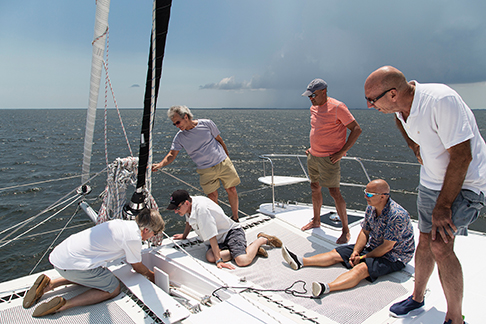
Sailing the boat was obviously one of the most anticipated portions of Antares University Rob and Jeff went through how to raise, reef and douse the suit of sails that are commonly used. We pointed with the genoa and reached and ran with the screecher. We learned about sail shape and control of the large main. We got to take turns at the wheel to feel how the big cat handled, tacked and tracked. We played with the autopilot and complex electronics and radar. Looking out over the bow from the protected helm seat, we could envision the exotic oceans and lands that we will someday see over the bow of our own Antares.
The class was also a chance to meet other soon-to-be owners, both for the two days on the boat as well as for an evening get-together to relax and get to know one another better. It’s always exciting to share discussions of cruising plans, as well as to meet people from across the country and around the world. Everyone exchanged contact information to keep in touch as cruising plans evolve. The more recent gathering in Florida also gave us the chance to learn more about the area where the boat is built in Argentina and some of the logistical questions we’ve had about delivery of the boat and moving aboard. Rob and Salwa put together a great video outlining some of the common questions they’ve received about the process as well as cruising grounds along the eastern coast of South America.
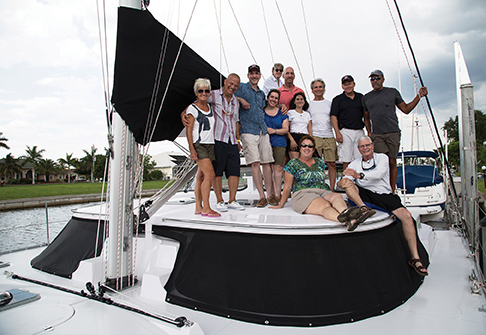
The bottom line of Antares University is that it has given us the opportunity to discover the boat in a thorough way before ours has been completed. We know that we will get a complete orientation when the boat actually splashes, but it has given us insight into the systems as well as helped us decide between some of the options in building ours. Above all, what we have taken home from these experiences is the sense of community amongst Antares owners and the company. This is a close knit and friendly group, and we have truly enjoyed these learning vacations. They have indeed been a great introduction to our new life aboard—one that we cannot wait to start.















